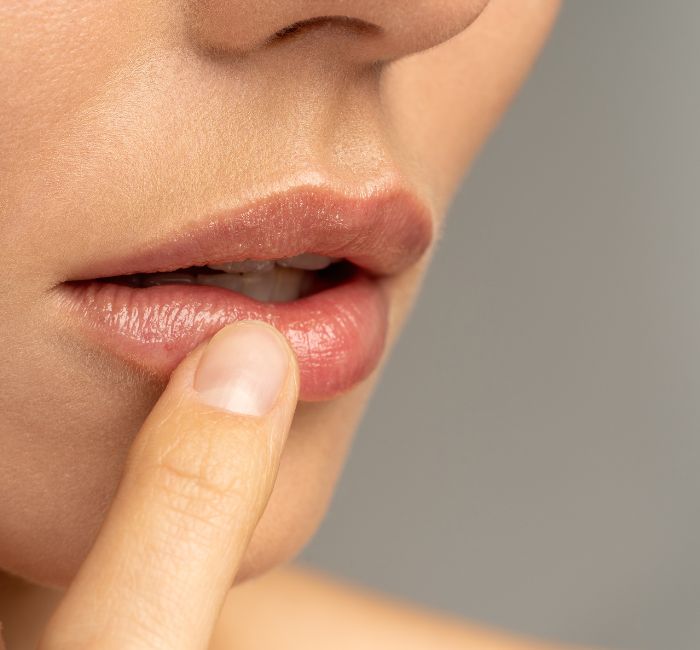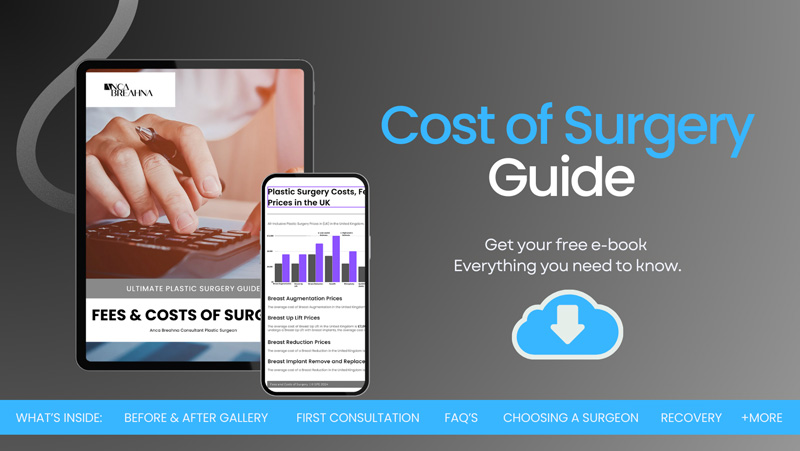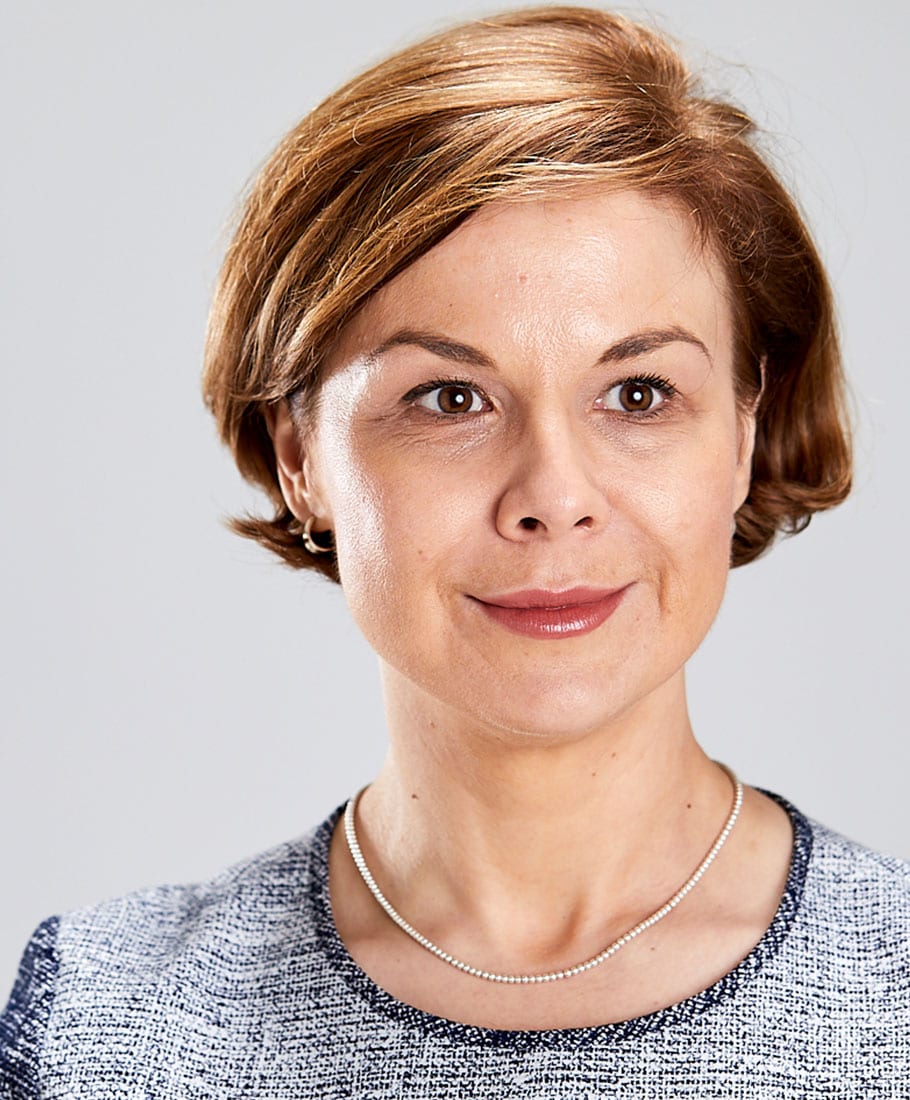Procedures
Lip Lesion Excision/ Removal

The removal of lip lesions is a surgical procedure that addresses abnormalities on the lips, which could range from benign (non-cancerous) growths to malignant (cancerous) tissues. This operation not only aims at enhancing the aesthetic appearance of the lips but also plays a significant role in maintaining oral health by preventing the development of more serious conditions. Lip lesions can vary widely in their appearance and severity, from small, innocuous spots to larger, more conspicuous growths. Some may be present from birth, while others could develop over time due to factors like sun exposure, infections, or lifestyle habits. Regardless of the type, size, or cause of the lesion, the goal of excision or removal is to restore the lips to a healthier state, both functionally and aesthetically.
As a trained professional in the field, Chester Consultant Plastic Surgeon Anca Breahna possesses the necessary qualifications and experience to conduct lip lesion excision or removal surgeries.
At a glance
Less than 1 hour
Local anaesthesia
A few days
Table of Contents
What is Lip Lesion Excision/ Removal?
Lip lesion excision or removal is a specialised surgical procedure aimed at eradicating abnormal growths or marks from the lips. These lesions can be anything that deviates from the normal appearance of the lip tissue, ranging from benign lumps and bumps to potentially cancerous or precancerous changes. The process involves the careful removal of the lesion, along with a margin of healthy tissue around it, to ensure that all potentially harmful cells are eliminated.
This procedure is not only about removing the lesion but also involves analysing the removed tissue through a biopsy. This analysis is essential as it helps determine whether the lesion is benign or malignant, guiding the need for any further treatment. The primary aim here is to address any condition that might pose a risk to your health or cause discomfort, while also working towards restoring the natural appearance of your lips.
For many individuals, the decision to have lip lesion excision or removal can be motivated by a variety of factors. Some might seek relief from physical discomfort caused by the lesion, such as pain or irritation, especially when eating, talking, or engaging in other mouth-related movements. For others, the concern might be more aesthetic, seeking to remove a lesion that they find unsightly or that affects their smile and overall facial expression.
In every case, the procedure is tailored to the individual’s specific condition and needs. The type of lesion, its size, location, and the presence of any symptoms are all considered when planning the surgery.
Who Needs Lip Lesion Excision/ Removal?
Lip lesion excision or removal is recommended for individuals displaying noticeable, persistent, or otherwise concerning lesions on their lips. These lesions can vary widely in their nature and appearance, including but not limited to, cold sores, canker sores, lipomas (benign fatty growths), fibromas (benign fibrous tissue growths), and potentially malignant or cancerous growths such as squamous cell carcinoma.
Ideal candidates for this surgery are those in good overall health, who do not smoke or are willing to quit (as smoking can significantly hinder the healing process), and who have realistic expectations regarding the outcomes of the procedure. It is critical for potential candidates to understand that while lip lesion excision or removal can significantly improve the appearance of the lips and eliminate discomfort, the results depend on the nature of the lesion, the method of removal, and individual healing processes.
Additionally, people with lesions that have not responded to other treatments, or those that have changed in appearance over time, may be advised to undergo excision or removal as a preventative measure against potential malignancy.
The decision to proceed with lip lesion excision or removal should be made after a thorough consultation with Anca, who can assess the lesion and discuss the most appropriate treatment options. During this consultation, it’s important to discuss any concerns and ask questions about the procedure, recovery, and any potential risks. A detailed medical history and physical examination will also help determine if you are a suitable candidate for the procedure.
Benefits of the Lip Lesion Excision Procedure
One of the primary advantages is the removal of the lesion itself, which can alleviate any discomfort, irritation, or pain associated with its presence. This, in turn, can make daily activities such as eating, speaking, and smiling much more comfortable.
From a health perspective, excising or removing a lip lesion allows for a detailed examination of the tissue, which is critical in cases where the nature of the lesion is uncertain. By performing a biopsy on the removed tissue, specialists can determine whether the lesion is benign or malignant, guiding any necessary follow-up treatment. This diagnostic benefit is invaluable, particularly for lesions with the potential to become cancerous over time.
Aesthetically, the removal of unsightly lesions can significantly enhance one’s appearance and restore a more natural look to the lips. For many individuals, this improvement in appearance can lead to a boost in self-assurance and a more positive self-perception.
Moreover, in cases where the lesion is precancerous or malignant, its removal is a proactive step in preventing the development or spread of cancer. This can eliminate the need for more extensive treatments down the line, such as chemotherapy or radiation, which come with their own set of challenges and side effects.
Types of Procedures
Simple Excision
This is the most direct approach, where the lesion is cut out along with a small margin of the surrounding healthy tissue. This method is typically used for smaller lesions that are well-defined. The primary advantage of simple excision is its straightforwardness, allowing for the complete removal of the lesion in one procedure. The removed tissue is often sent for histological analysis to ensure all abnormal cells have been eliminated and to provide a definitive diagnosis.
Shave Excision
Ideal for lesions that protrude above the skin’s surface, shave excision involves using a sharp blade to shave off the lesion. This technique is less invasive than a simple excision and is preferred for superficial lesions that do not penetrate deeply into the underlying tissues. One of the benefits of shave excision is that it usually results in less scarring compared to other methods.
Laser Surgery
Utilising a focused beam of light, laser surgery allows for precise removal of the lesion with minimal damage to the surrounding tissues. This method is particularly useful for vascular lesions or those located in difficult-to-reach areas. Laser surgery has the advantage of reducing bleeding during the procedure and minimising the risk of infection and scarring post-operation.
Cryosurgery
This technique involves freezing the lesion with liquid nitrogen, causing it to die and eventually fall off. Cryosurgery is a good option for small, superficial lesions and is known for its minimal invasiveness. The procedure is quick and often requires no stitches, although it may require multiple sessions to completely remove the lesion.
How is the Lip Lesion Excision Procedure Performed?
The lip lesion excision or removal procedure is usually performed under local anaesthesia, ensuring you remain comfortable and pain-free throughout the process. Depending on the size and type of the lesion, as well as the chosen method of removal, the specifics of the procedure can vary. However, the general steps are as follows:
First, the area around the lesion is cleaned and sterilised. A local anaesthetic is then administered to numb the area, ensuring you do not feel any discomfort during the procedure. Depending on the technique being used, the lesion is carefully removed using the appropriate method (excision, shave, laser, or cryosurgery).
In cases where excision is chosen, Anca will make a precise cut to remove the lesion along with a margin of healthy tissue around it. This is to ensure that all potentially harmful cells are removed. The wound is then closed with stitches, if necessary, which helps to promote healing and minimise scarring.
The entire procedure usually takes less than an hour and is performed on an outpatient basis, meaning you can go home the same day. After the lesion is removed, it is often sent to a laboratory for histological analysis to determine its nature and ensure that the margins are clear of any abnormal cells.
When considering lip lesion excision or removal, it’s important to understand that there are several techniques available, each suited to different types of lesions. The choice of procedure largely depends on factors such as the lesion’s size, type, location, and whether it is benign or malignant. The most common types of lip lesion removal techniques are simple excision, shave excision, laser surgery and cryosurgery.
The decision on which method to use will be made by Anca based on a detailed examination of your lesion and consideration of your overall health and personal preferences. Each method has its benefits and limitations, and understanding these can help you make an informed decision about your treatment.
Recovery after Lip Lesion Excision Procedure
The recovery process following a lip lesion excision or removal is an important phase that demands careful attention to ensure optimal healing and minimise potential complications. While the specifics of recovery can vary depending on the individual and the extent of the procedure, there are general guidelines and expectations you should be aware of:
- Immediate Post-Operative Care: Immediately following the procedure, it’s common to experience some swelling, bruising, and discomfort around the treated area. These symptoms are usually mild and can be effectively managed with over-the-counter pain relief medication, as advised by Anca. Applying ice packs in the first 24-48 hours can also help reduce swelling.
- Wound Care: Proper care of the surgical site is essential for healing. You may be given specific instructions on how to clean the area and how often to change any dressings. It’s important to keep the area clean and dry to prevent infection. If sutures are used, they may need to be removed by Anca after a week or two, depending on the type of sutures and how well the site is healing.
- Diet and Activity Restrictions: To avoid disturbing the surgical site, you may be advised to follow a soft food diet temporarily and avoid vigorous physical activity for a certain period. Smoking and alcohol consumption should also be avoided as they can impair the healing process.
- Follow-Up Visits: Attending follow-up appointments with Anca is essential for monitoring the healing process and removing sutures if necessary. These visits are also an opportunity to address any concerns or questions you may have about your recovery.
- Healing Time: The total healing time can vary, with most people able to resume their normal activities within a few days. However, complete healing of the site, including the resolution of any scarring, may take several weeks to months. It’s important to have realistic expectations and to give your body the time it needs to heal fully.
Reviews
Patient satisfaction is the top priority for Anca. You can find how patients feel about her work below.
Miss Breahna removed a cancerous nodule from my forehead in March 2021. I was quite nervous when I arrived at the hospital, but when I was greeted by a member of her team I started to feel calmer as they were so professional and friendly.
Once inside the theatre Miss Breahna and her team helped me to feel relaxed and comfortable throughout, the team atmosphere was friendly and upbeat during my operation and I was looked after wonderfully. I would recommend Miss Breahna and her team to anyone requiring this type of surgery.
Kate Hodson

Ms Anca Breahna was most kind and empathetic during my recent procedure for skin cancer. She reassured me that I’m now completely clear, I have total confidence in her and would recommend her unreservedly. Thank you Anca.

Wish I’d Done It Sooner! I am so pleased with the results
After searching and deliberating for a long time, I consulted Anca regarding the removal of 3 lipomas. From start to finish, she was fantastic! One of the lipomas was on my forehead and I have to search for the scar! I am so pleased with the results of all and the one regret is that I didn’t find her sooner. I wouldn’t hesitate to recommend her
How Much Is Lip Lesion Excision in the UK?
In the UK, the cost for the excision of a lip lesion can vary significantly, depending on the healthcare setting and whether the procedure is conducted privately or through the NHS.
Please contact us for an estimated price range. The cost usually includes the surgical removal of the lesion and the fee for the pathologist to examine the tissue to determine if further treatment is necessary. Factors that can affect the price include the complexity of the procedure, the type of anaesthesia used, and whether any reconstructive work is required post-removal.
Cost of Surgery Guide

Further Reading
- Read Anca’s Blog on Treatment Options for Lipoma and Other Swellings
- Read Anca’s Blog on How to Get Rid of Moles

Procedure
Frequently asked questions
What are the risks of Lip Lesion Excision?
While lip lesion excision or removal is generally safe and effective, as with any surgical procedure, there are potential risks and complications that you should be aware of. Although rare, there is a risk of infection at the surgical site. Signs of infection include increased redness, swelling, warmth, and the presence of pus. Some bleeding at the site of the excision is normal, but significant bleeding should be promptly addressed. Any surgical procedure carries the risk of scarring. While efforts are made to minimise scarring and place incisions strategically, the extent and visibility of scars can vary depending on individual healing factors. There can be temporary or, in rare cases, permanent changes in sensation (such as numbness) in the treated area. Additionally, if a large lesion is removed or if the procedure is not symmetrically performed, it could potentially affect the symmetry of the lips.
How long does the lip lesion excision or removal procedure take?
The duration of a lip lesion excision or removal procedure typically ranges from 30 minutes to an hour, depending on the complexity of the lesion and the method used for removal. The procedure is usually done on an outpatient basis, allowing you to go home the same day.
Will I be awake during the lip lesion excision procedure?
Yes, most lip lesion excision or removal procedures are performed under local anaesthesia, which numbs the area around the lesion. You’ll be awake during the procedure but should not feel any pain, just some pressure or movement.
Can lip lesion excision or removal procedures be performed on children?
Yes, lip lesion excision or removal can be safely performed on children, provided the procedure is deemed necessary by a healthcare provider. The approach and anaesthesia used may vary depending on the child’s age, the size and location of the lesion, and other health considerations.
How soon after the procedure can I eat and drink?
You can typically eat and drink a few hours after the procedure, once the local anaesthesia has worn off. However, you may be advised to stick to soft foods and avoid hot beverages or spicy foods for a short period to avoid irritating the surgical site.
Medical References about Lip Lesion Excision/ Removal
- Ganglion Cyst: Symptoms, Causes, Diagnosis – WebMD
- Excision of Ganglion Cysts – Oxford Academic
- Ganglion Cysts – Cleveland Clinic
- Ganglion Cyst – Mayo Clinic
- Ganglion Cyst – NCBI
 Ms Anca Breahna, PhD, MSc, FEBOPRAS, FRCS (Plast) is a highly regarded Consultant Plastic Surgeon specialising in the field of Aesthetic and Reconstructive Plastic Surgery. Anca performs a range of
Ms Anca Breahna, PhD, MSc, FEBOPRAS, FRCS (Plast) is a highly regarded Consultant Plastic Surgeon specialising in the field of Aesthetic and Reconstructive Plastic Surgery. Anca performs a range of 